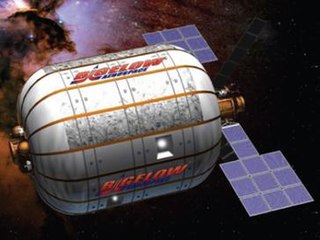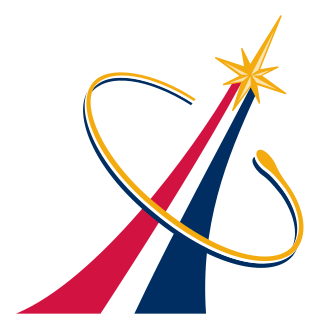
A space station is a spacecraft which remains in orbit and hosts humans for extended periods of time. It therefore is an artificial satellite featuring habitation facilities. The purpose of maintaining a space station varies depending on the program. Most often space stations have been research stations, but they have also served military or commercial uses, such as hosting space tourists.
Human spaceflight programs have been conducted, started, or planned by multiple countries and companies. Until the 21st century, human spaceflight programs were sponsored exclusively by governments, through either the military or civilian space agencies. With the launch of the privately funded SpaceShipOne in 2004, a new category of human spaceflight programs – commercial human spaceflight – arrived. By the end of 2022, three countries and one private company (SpaceX) had successfully launched humans to Earth orbit, and two private companies had launched humans on a suborbital trajectory.
Bigelow Aerospace was an American space design and manufacturing company which closed its doors in 2020. It was an aeronautics and outer space technology company which manufactured and developed expandable space station modules. Bigelow Aerospace was founded by Robert Bigelow in 1998, and was based in North Las Vegas, Nevada. It was funded in large part by the profit Bigelow gained through his ownership of the hotel chain, Budget Suites of America.

Blue Origin Enterprises, L.P. is an American space technology company headquartered in Kent, Washington. The company operates the suborbital New Shepard rocket and is developing the heavy-lift New Glenn rocket. In addition to producing engines for its own rockets, Blue Origin supplies engines for other vehicles, including United Launch Alliance's Vulcan Centaur. It is also working on the Blue Moon human lunar lander for NASA's Artemis program, the Blue Ring spacecraft platform, and the Orbital Reef space station in partnership with other organizations.

Dream Chaser is an American reusable lifting-body spaceplane developed by Sierra Space. Originally intended as a crewed vehicle, the Dream Chaser Space System is set to be produced after the Dream Chaser Cargo System cargo variant is operational. The crewed variant is planned to carry up to seven people and cargo to and from low Earth orbit. Sierra plans to manufacture a fleet of the spaceplane.

The B330 was an inflatable space habitat privately developed by Bigelow Aerospace from 2010 until 2020. The design was evolved from NASA's TransHab habitat concept. B330 was to have 330 cubic meters (12,000 cu ft) of internal volume, hence its numeric designation.

Inflatable habitats or expandable habitats are pressurized tent-like structures capable of supporting life in outer space whose internal volume increases after launch. They have frequently been proposed for use in space applications to provide a greater volume of living space for a given mass.

The Boeing Starliner is a spacecraft designed to transport crew to and from the International Space Station (ISS) and other low-Earth-orbit destinations. Developed by Boeing under NASA's Commercial Crew Program (CCP), it consists of a reusable crew capsule and an expendable service module.

Development of the Commercial Crew Program (CCDev) began in the second round of the program, which was rescoped from a smaller technology development program for human spaceflight to a competitive development program that would produce the spacecraft to be used to provide crew transportation services to and from the International Space Station (ISS). To implement the program, NASA awarded a series of competitive fixed-price contracts to private vendors starting in 2011. Operational contracts to fly astronauts were awarded in September 2014 to SpaceX and Boeing, and NASA expected each company to complete development and achieve crew rating in 2017. Each company performed an uncrewed orbital test flight in 2019.

Liberty was a 2011 launch vehicle concept proposed by ATK and Airbus Defence and Space for phase 2 of the NASA Commercial Crew Development (CCDev) program intended to stimulate development of privately operated crew vehicles to low Earth orbit.

The Artemis program is a Moon exploration program led by the United States' National Aeronautics and Space Administration (NASA), formally established in 2017 via Space Policy Directive 1. It is intended to reestablish a human presence on the Moon for the first time since the Apollo 17 mission in 1972. The program's stated long-term goal is to establish a permanent base on the Moon to facilitate human missions to Mars.

The Gateway Logistics Services will be a series of uncrewed spaceflights to the Lunar Gateway space station, with the purpose of providing logistical services to the Gateway. Overseen by NASA's Gateway Logistics Element, the flights will be operated by commercial providers, contracted by the agency in support of crewed expeditions to the Gateway made under the Artemis program. As of March 2023, SpaceX is the only company contracted to provide the services.

The Commercial Crew Program (CCP) provides commercially operated crew transportation service to and from the International Space Station (ISS) under contract to NASA, conducting crew rotations between the expeditions of the International Space Station program. American space manufacturer SpaceX began providing service in 2020, using the Crew Dragon spacecraft, and NASA plans to add Boeing when its Boeing Starliner spacecraft becomes operational no earlier than 2025. NASA has contracted for six operational missions from Boeing and fourteen from SpaceX, ensuring sufficient support for ISS through 2030.

Axiom Station is a planned modular space station designed by Houston, Texas-based Axiom Space for commercial space activities. Axiom Space gained initial NASA approval for the venture in January 2020. Axiom Space was later awarded the contract by NASA on February 28, 2020. Axiom Station is one of multiple Commercial LEO Destinations (CLD) projects supported by NASA to build a successor to the International Space Station (ISS) before its decommissioning in 2030.

The Power and Propulsion Element (PPE), previously known as the Asteroid Redirect Vehicle propulsion system, is a planned solar electric ion propulsion module being developed by Maxar Technologies for NASA. It is one of the major components of the Lunar Gateway. The PPE will allow access to the entire lunar surface and a wide range of lunar orbits and double as a space tug for visiting craft.
Starlab is a LEO commercial space station currently under development by Starlab Space, a joint venture between the U.S. company Voyager Space and European company Airbus. If development continues beyond the initially-funded phase in 2021–24, then Starlab would be launched before the decommissioning of the ISS, no earlier than 2028. The development program has received partial funding from both NASA and the ESA.
Sierra Space Corporation is a privately held aerospace and space technologies company headquartered in Louisville, Colorado, with additional facilities in Colorado, Wisconsin, Florida, North Carolina and a testing site at the Marshall Space Flight Center in Alabama. The company makes spaceflight hardware for various applications across the industry. It is currently developing the Dream Chaser spaceplane. The spaceplane was selected by NASA to provide services to the International Space Station under NASA's Commercial Resupply Service 2 contract. The company is also in collaboration with Blue Origin to develop components of the Orbital Reef space station.
The Commercial LEO Destinations program is a public/private partnership program of the NASA, to help facilitate the building of private commercial space stations (CSSs) in low Earth orbit.














